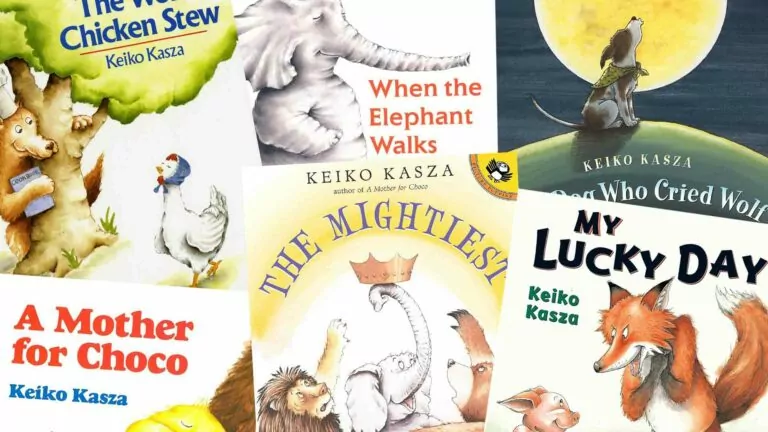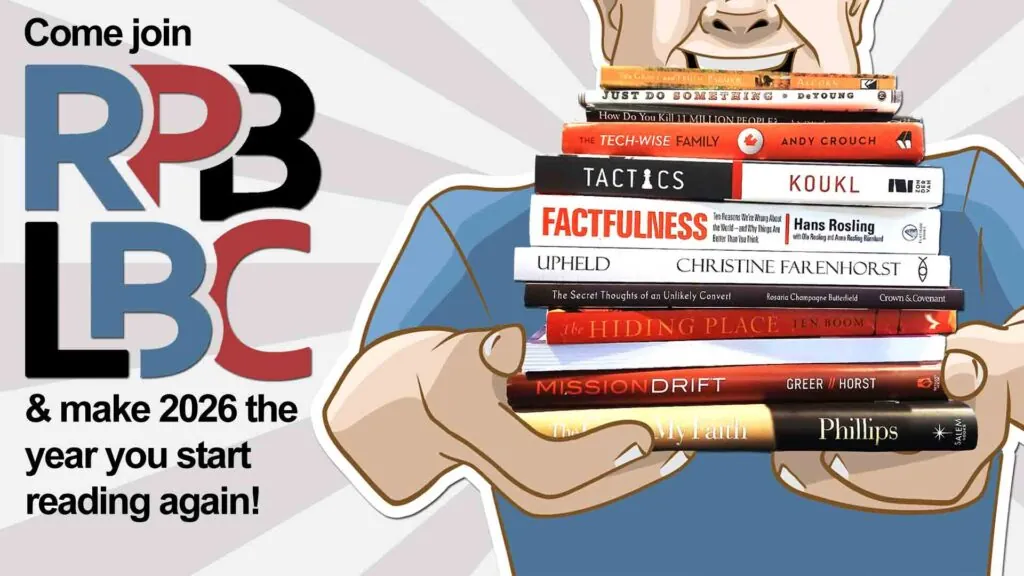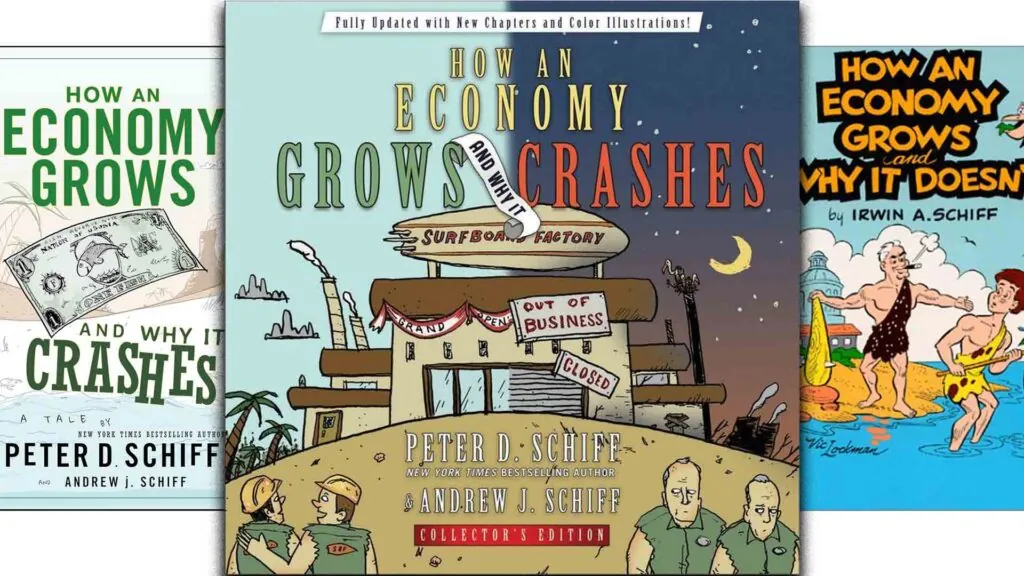Author and illustrator Keiko Kasza was born in Japan and moved to the US for college only to meet and marry an American and then become American herself. On her website she shares the fun factoid that while her last name sounds Japanese, it actually comes from her husband, whose family has Hungarian roots.
Kasza loves to people her stories with adorable furry and feathered friends, and illustrates in a somewhat cartoonish style, coloring characters in bright colors and surrounding them with plenty of bright white space. There’s often a gentle moral shared, and of the sort that’d we’d appreciate, like: adoption is good, try to be brave, grandparents have lessons to share, and sometimes two disagreeing friends may discover they have both been a little wrong and a little right.
There’s a sense of playfulness to her work, perhaps because some of her books come off a little like a joke, the build-up leading to a satisfying punchline. And, at 32 pages each (and shorter for the board book), they are all pretty quick reads, which means you can share two or three at a time with your little ones.
Sadly, some of her titles aren’t readily available, so I’ve noted the ones that are easier to get by including a cover picture. But all twelve of the recommendations are worth putting in some effort to track down.
RECOMMENDED (12)
Silly Goose’s Big Story (2012)
Goose is so good at making up stories, his friends always ask him for more. But when the roles get handed out, his friends start noticing that Goose always gets the hero role. And they want a turn too. Goose isn’t about to do that. Then a wolf interrupts things, swoops up Goose, and tells him, “So you’re the hero, huh? More like a hero sandwich to me!” Goose can’t get away. But he can tell a story. So Goose tells the most outlandish story about a wolf-eating monster that lives in the area. And who should be coming through the woods right then, but the monster himself! Wolf runs off, and we discover the monster is nothing more than Goose’s three friends stacked atop each other. Goose gives them thanks, and notes that they are the real heroes! It’s a sweet story, where friends fight, but figure it out… with some help from a wolf. 🙂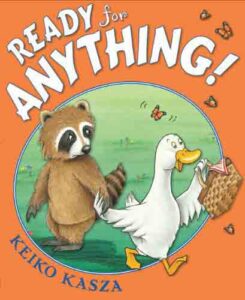
Ready for Anything! (2009)
Duck wants to go on a picnic, but Raccoon wonders, what if killer bees, or a terrible storm, or even a ferocious dragon make an appearance? In contrast, Duck is a glass-half-full kind of guy, and has his own what ifs to share: what if butterflies pass by, and what if the weather is warm and the breeze just strong enough to blow a kite? Raccoon agrees to go, but brings loads of gear – he’s ready for anything! – and actually saves the day when Duck forgets to bring their food. I loved that both friends learn a lesson: Raccoon learns not to obsess about the bad, and Duck learns that it’s not crazy to prepare for bad stuff, because it does sometimes happen.
The Dog Who Cried Wolf (2005)
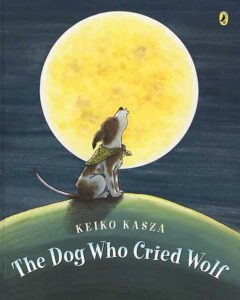 When Moka’s owner reads a book about wolves, Moka starts getting jealous. He wishes he could be a wolf. So the next day he takes off for the mountains. The only caution for the book concerns his celebration: “He ran. He jumped. He danced. And he peed where he wanted.” That is, however, the only bit of potty humor. And soon after celebrating his freedom Moka realizes it isn’t all that it is cracked up to be. He is soon very hungry, and he can’t catch his dinner. Then, when he meets a pack of real wolves, Moka realizes that he never understood how good he had it back home. When he runs back, he’s met at the gate by his master, her arms wide open to hug him – this could have been titled “The Prodigal Dog”!
When Moka’s owner reads a book about wolves, Moka starts getting jealous. He wishes he could be a wolf. So the next day he takes off for the mountains. The only caution for the book concerns his celebration: “He ran. He jumped. He danced. And he peed where he wanted.” That is, however, the only bit of potty humor. And soon after celebrating his freedom Moka realizes it isn’t all that it is cracked up to be. He is soon very hungry, and he can’t catch his dinner. Then, when he meets a pack of real wolves, Moka realizes that he never understood how good he had it back home. When he runs back, he’s met at the gate by his master, her arms wide open to hug him – this could have been titled “The Prodigal Dog”!
The Mightiest (2003)
A lion, bear, and elephant happen upon a crown with an inscription that says it is for the mightiest. To figure out how should get it, they take turns trying to scare an old lady. Each, in turn, manages to “scare the daylights out of” the old lady. But then the three of them get scared themselves when a giant comes along and scoops them all up. “Help!” they all cry, and who should rescue them but the little old lady. She is the giant’s mama, and since he’s sure scared to disobey her, isn’t she the mightiest of this whole lot?
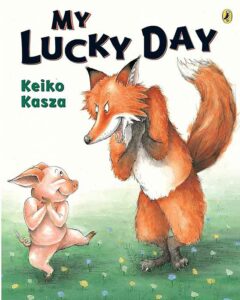 My Lucky Day (2003)
My Lucky Day (2003)
A hungry wolf thinks it must be his lucky day when a delicious piglet, looking for his friend rabbit, knocks on the door. But as the wolf’s dinner prep begins, the piglet notes “I’m filthy. Shouldn’t you wash me first?” And so the wolf sets out to collect wood, start a fire, draw the water and give the piglet a wonderful scrub. As they head back to the kitchen the piglet notes, he’s quite small, and wouldn’t he be more delicious if the wolf fattened him up. Yes, the wolf agrees, and he picks tomatoes, cooks spaghetti, bakes cookies, etc. Piglet ends up having such a wonderful time that he thinks it must be his lucky day. And the wolf gets so tuckered, the piglet easily makes his escape. There is a sequel, My Lucky Birthday (2013), that’s almost its match, marred by one use of “gosh.”
Don’t Laugh, Joe! (1997)
Joe is a young possum who can’t help but giggle. That’s fun for all his friends, but his mom is worried that it might give him away when danger comes – after all, possums evade danger by playing dead, and no predator is going to believe a laughing possum is dead. But with a little help from a grumpy bear, he figures it out… and helps the grumpy bear see the funny side of things too.
 A Mother for Choco (1996)
A Mother for Choco (1996)
A little bird looking for a mother finds a giraffe that’s the right color… but she doesn’t have wings. A penguin mother has wings, but doesn’t have Choco’s round cheeks. And so the hunt goes on. Finally she meets mother bear, who looks nothing like Choco, but wants to hug and kiss her like a mom would. And they decide that’s what matters. Choco heads home with the bear, and discovers she has other children that also don’t look like her: a pig, a crocodile, and a hippo. I think the point of this is to celebrate adoption, and it does a good job (though I would have liked it more if dad bear had shown up).
Grandpa Toad’s Secrets (1995)
On a walk in the forest, Grandpa toad shares with his little grandson three secrets to dealing with danger. The first is to be brave, and when a snake jumps out to eat them, Grandpa puts his advice into action. He puffs himself up, until he’s twice his normal size and shoos the snake away. His second piece of advice? Be smart! When a huge snapping turtle tries to eat them, Grandpa tells the turtle about an even tastier snack that just slithered by only moments before. Before he can give his third piece of advice, a monster grabs him. Thankfully, little grandson has been listening, and uses the first two tips to mount a very brave and very smart rescue of his dear ol’ grandpappy. A very fun story!
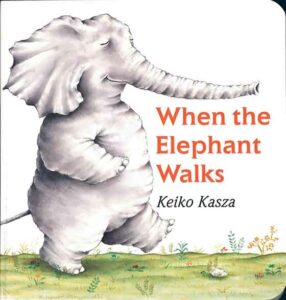 When the Elephant Walks (1990)
When the Elephant Walks (1990)
A scared elephant scares a bear, who in turn scares a crocodile, and so on, until we have a running raccoon accidentally scaring a mouse. Will it all stop with the mouse? Who would be scared by a mouse? Well… an elephant of course! So round we go once more. This board book is clever, but it is very short, taking just a minute to read.
The Pig’s Picnic (1988)
Mr. Pig wants to ask Miss Pig out for a picnic, and on the way to her house, he meets three friends, who all want to help him look his very best. Fox loans the pig his bushy tail, while Lion gives his hair, and Zebra shares his stripes. But with Mr. Pig now looking so very different, Miss Pig slams the door on him. And when he comes back looking like himself, she is happy to go on a picnic with him, and eager to tell him about the ugly monster that had visited that morning. The moral of the story is to be yourself, not someone else.
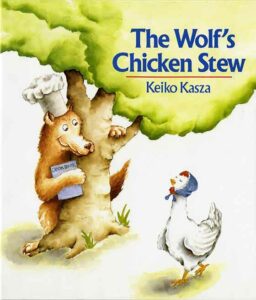 The Wolf’s Chicken Stew (1987)
The Wolf’s Chicken Stew (1987)
A wolf anticipates eating a wonderful chicken stew. But before pouncing on the chicken, he leaves gifts of 100 pancakes, followed by 100 doughnuts, then a 100-pound cake, all in an effort to fatten the chicken up. When he finally thinks it’s time to pounce, he goes to her house only to discover a grateful brood of 100 chicks who have been enjoying his cooking. The newly minted “Uncle Wolf” gratefully receives their 100 kisses.
TAKE IT OR LEAVE IT (1)
Badger’s Fancy Meal (2007)
Badger has plenty to eat in his hole, but wants something fancy. So he goes after a mole, rat, and rabbit, all of them escaping in turn by diving into the hole he just left…where they find what, in their eyes at least, is a fancy feast just waiting for them. When the Badger finally returns to his den he finds his food gone. All that’s left is a note, signed by three critters:
“Sorry for dropping by uninvited. A nasty badger was chasing us and we had nowhere else to hide. The apples, worms and roots were delicious.”
The bad guy gets what he deserves, which is good. But the reason I didn’t rate this higher is because as parents we also need to teach our children that we should be thankful that God is not giving us what we deserve.
DON’T BOTHER (3)
Finders, Keepers! (2015)
A little squirrel in a bright red hat finds a big acorn and celebrates with a shout of “Finders Keepers.” He buries it for later, marking the spot with his hat, which is later found by a bird, who thinks it would make for a great nest and takes his turn at declaring “Finders Keepers.” And on it goes. This is a light-hearted tale but only because it completely ignores that finders keeping leads to losers weeping. We don’t want our kids living out the moral of this story: instead of being keepers, finders should try to be returners.
Dorothy and Mikey (2000)
Two hippopotamus best friends share three stories here, all three of which center around fights. In the second, Dorothy pulls a trick on Mikey because he’s being all braggadocios about how much better he is at their contests. She challenges him to a contest of standing on one leg with eyes closed to see who can do it longer. But once they start, she goes home and enjoys a nice cool lemonade while Mike continues standing on one leg in the hot sun for hours, thinking she is there too. This is just returning evil for evil, which God doesn’t want us to do (1 Pet. 3:9).
The Rat and the Tiger (1993)
A little rat is best friends with a big tiger who isn’t always looking out for his little friend. For example, when they play cowboys, Tiger always gets to be the good guy, and Rat has to be the bad guy. After a lot of this, Rat gets fed up and won’t be friends with Tiger until Tiger gets a taste of his own treatment. But while Tiger was thoughtless, Rat treats Tiger badly on purpose. This is one to give a miss because as much as the world preaches it, we don’t want our kids to ever believe two wrongs make a right.







